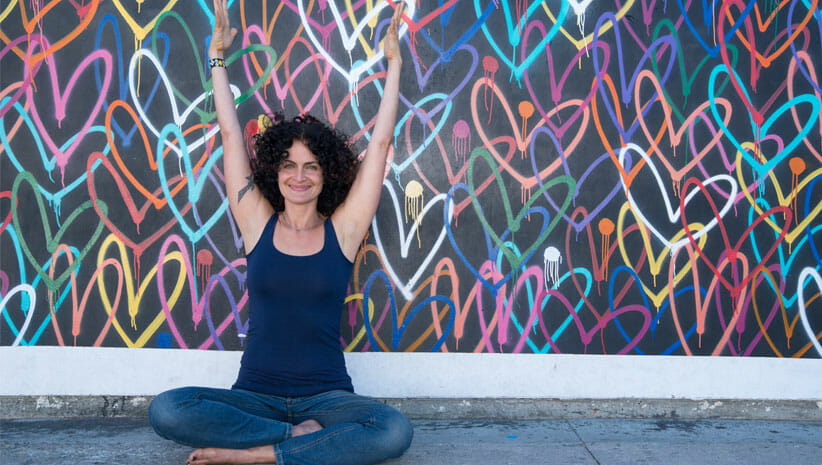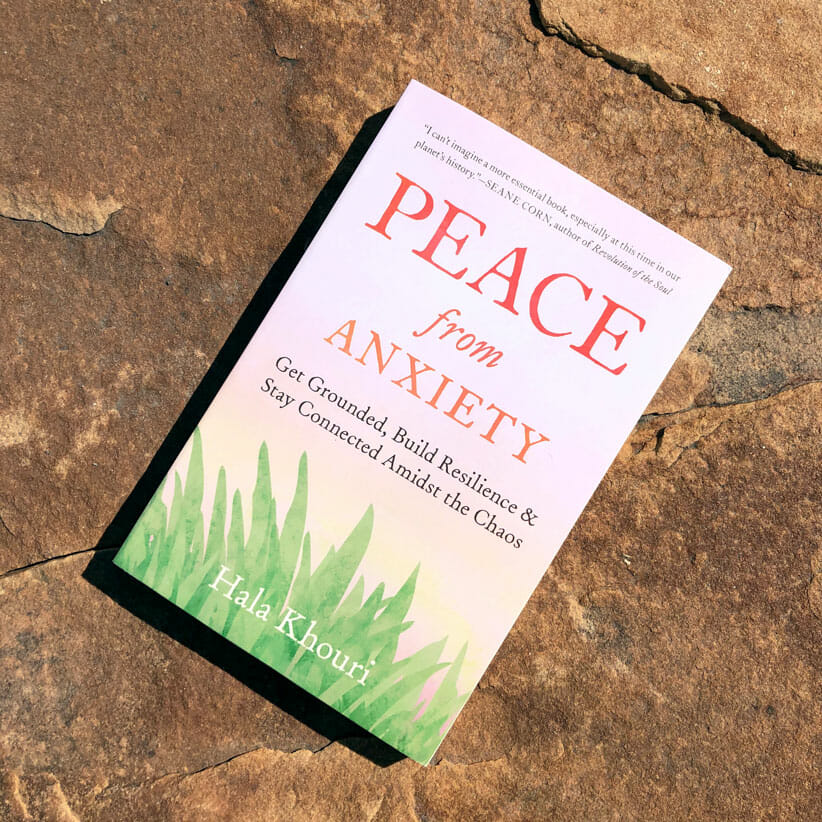
Hala Khouri Photo by Sarit Rogers
What Does it Mean to Participate in Redefining Self in These Times?
There is a collective anxiety that many people are experiencing these days. It’s an anxiety about the state of the world—politics, the environment, lack of safety in public spaces, our relationship to people different from us. For some people, this is not new, and for others it is a disruption of a feeling of peace and stability that they’ve been accustomed to. So, whether you just got to the collective anxiety party or you and your community have been here for generations, it’s undeniable that right now, at the time of the writing of this book, there is a sense of unease about our future on a national and global level. There is a collective pain that many people don’t know what to do with. Some people want to bury their heads in the sand, others don’t have that option, and many are looking for ways to cope and even contribute to making things better.
This is a time where we might finally choose to use our collective pain to transform us. We all have a different role to play, and we need to figure out how to work together to make the world a better place for all beings. I believe that as a global culture we are being asked to love bigger than we ever have and that this is what will help us navigate our way out of this overwhelm.
In the book Peace from Anxiety, I touch into what it means to be a global citizen and help build a culture of care for all living things. This requires us to have what I like to call a “global heart.” Some questions I ask myself are: How can I turn my overwhelm into overwhelming love? How can I let the whole world into my heart, so my heart can be bigger and more loving? How can I let my heart break open rather than break apart? How can I let my pain transform me? I don’t have lots of clear answers to these questions, but I try and let them guide me whenever possible.
“It’s All in Our Face Now”
Yesterday, a friend said this to me: “Everything is in our face now. We can’t get away from all that is happening in the world.” Why is it all in our face now? It’s partly due to the twenty-four-hour news cycle and our ability to access information about local and global issues with a single click. We receive information (and misinformation and disinformation) at a rate and speed that was unfathomable to the generations before us. None of us can keep up! Our nervous systems were not designed for this amount of input.
There is an interpersonal impact of technology and social media; there are also political and cultural implications to this technology. On a positive note, social media platforms can spread the stories and messages of those who have been historically silenced. Whether it’s a Black mother who lost her child to racially motivated violence or an Indigenous group protecting their land and water, we can connect visually and emotionally to people and events in a way that wasn’t possible in the past. With the Internet we can have immediate access to video footage of a school right after a mass shooting and displaced people fleeing violence in other countries. We can donate money, sign petitions, and share their stories to bring awareness to their plight. Social media can be a way to organize movements and protests, such as in Hong Kong or Beirut.
Our hyperconnectivity can allow us to be aware of and act swiftly to address some of the tragedies that are happening far away or close by. The author and organizer Adrienne Maree Brown said in a Tweet, “Things are not getting worse, they are being revealed. We must hold each other tight and continue to pull back the veil.”I agree wholeheartedly, and I think that much of our work as a global society is to face what needs to change while finding ways to unite around a common goal.
Collective Overwhelm
The flip side to all this access is overwhelm. Overwhelm can lead to immobility, apathy, or desensitization. News and information is available to us all day and night, often via notifications on our phones alerting us to breaking news just minutes after an event occurs. This can distract us in moments when we need to be focused on other things, and it can disrupt moments of peace and stillness. A recent study found that the average person in the US checks their phone eighty times a day, and most of us don’t go more than ten minutes without looking at the device.
The Center for Humane Technology has a website with ideas for how to control your technology rather than having it control you. The center warns, “The extractive attention economy is tearing apart our shared social fabric.” The more that our devices get our attention, the less the world immediately around us does. Many of us are being desensitized as we are overexposed to “breaking news” and shocking headlines multiple times a day. How often do you find yourself skimming a headline about something that, in the past, would have made you pause, reflect, get more information, or take action? Now we can read something important and just move on to the next thing automatically.
REFLECTION
What are your habits around technology and news?
MEDIA HYGIENE PRACTICE
- What can you do to curate your media consumption so that it is deliberate and useful, rather than distracting and overwhelming?
- Consider how you can set alerts, how you can create time boundaries around technology, and how you can start and end your day.
- If you currently stay away from the news completely, what might it look like to engage in a way that is not overwhelming?
In addition to having access to important stories that need to be told, we are inundated with fake news stories curated to enrage and divide us. Often, we don’t know what to believe because many news outlets are no longer impartial conveyers of information. The have to compete with the abundance of content available to people, and the only way to get peoples’ attention is through sensationalized headlines and stories. In addition, most smartphones and news and entertainment platforms are designed to get us hooked. As James Williams, cofounder of the initiative Time Well Spent, a movement to help people take control of their technology use, says, “The attention economy incentivizes the design of technologies that grab our attention. In so doing, it privileges our impulses over our intentions. That means privileging what is sensational over what is nuanced, appealing to emotion, anger and outrage.”
The way that computer algorithms are set up, many of us find ourselves in an echo chamber where we only see the news that is in alignment with our views. Our browsers automatically show us news articles that fit our profile and user history. We rarely see opposing points of view, so we get more and more entrenched in what we believe and less exposed to other perspectives. This, coupled with the lack of nuance in most stories, decreases our tolerance of opposing viewpoints. In his book Why We’re Polarized, Ezra Klein, cofounder of Vox, makes the point that the United States is more politically polarized than ever.5 Historically, the country’s political parties did not generate a strong sense of group affiliation. Each party included people of many races, genders, and economic classes. This is not true today, and people’s party affiliation seems define them more than ever. According to the Pew Research Center, “Political polarization—the vast and growing gap between liberals and conservatives, Republicans and Democrats—is a defining feature of American politics today.”
This polarization has us fearing those on the “other side” and pointing fingers at all the ways everyone else is wrong, bad, and even dangerous. We are also fighting among each other and unable to tolerate differences even with people who share our same general viewpoint!
Collective anxiety is running high as people are getting more and more suspicious. Our faith in each other is eroding. We dehumanize people or groups who we perceive don’t have the same values as us, and this makes a constructive conversation almost impossible. This is the collective fight-or-flight response in action, and it goes against our best interests. One way to address this collective overwhelm is to challenge this response.
A Paradigm Shift: Collective Care
A culture of collective care asks us to let the whole world into our hearts. To move toward one another when things are difficult rather than away. It asks us to see ourselves in everyone, and all people as equal. It asks us to know our different roles in the movement for change and value and respect all roles, even (or perhaps especially) the less visible ones. It requires some of us to step up and some of us to get out of the way. Collective care means that we have each other’s backs and think about the impact of our actions on all beings. It invites us to see well-being as everyone’s birthright, and our mutual responsibility in ensuring this well-being for everyone as a natural part of life rather than a burden or a form of special altruism.
Addressing our collective anxiety is going to require continued work on so many levels—politics, environmental policy, economic structures, education, health care, immigration, and more. One thing we all can do to contribute to a culture of care is redefine what we think well-being is. Kerri Kelly, founder of CTZNWELL,7an organization dedicated to democratizing well-being and making it accessible to everyone, says, “Well-being is not a privilege, it is a human right. But we live in a system that privileges well-being to those with time, access, and money. We have a responsibility as citizens to actively create the conditions of belonging, safety, and well-being so that everyone can thrive.”
A culture of care prioritizes the well-being of all people equally, and it values environmental sustainability and respect for non-human life as well. Martin Luther King Jr. called this the Beloved Community, which is a community founded on economic and social justice. When we can participate in a way that contributes toward collective care, we are able to be well ourselves. For some of us, this is exactly the missing element in our journey toward being well.
Practicing collective care is a paradigm shift for those of us brought up in more individualistic cultures. It asks us to reimagine what we have been taught about basic things like who we are, what real happiness is, and how we deal with conflict.

Peace from Anxiety
From Peace from Anxiety: Get Grounded, Build Resilience, and Stay Connected Amidst the Chaos by Hala Khouri © 2021 by Hala Khouri. Reprinted in arrangement with Shambhala Publications, Inc. Boulder, CO. www.shambhala.com.
Hala Khouri, MA, SEP, E-RYT, has been teaching yoga and movement for over 25 years and has been doing clinical work and trainings for 15 years. Originally from Beirut, Lebanon, she has dedicated her life to the study of trauma and building resilience on a personal, interpersonal, and systemic level. Hala is trained in Somatic Experiencing, a body-based psychotherapy that helps resolve trauma and its symptoms.
Hala is a co-founder of Off the Mat, Into the World, a training organization that bridges yoga and activism within a social justice framework. Hala also works with A Thousand Joys, training direct service providers and educators to be trauma informed and culturally responsive. She is a sought-after speaker and trainer on the subject of trauma, yoga, and social justice. She lives in Venice, CA with her husband and two sons and teaches yoga classes weekly. To learn more, please visit www.halakhouri.com.
